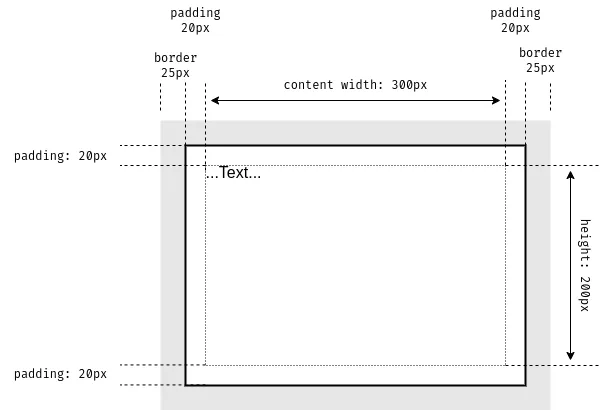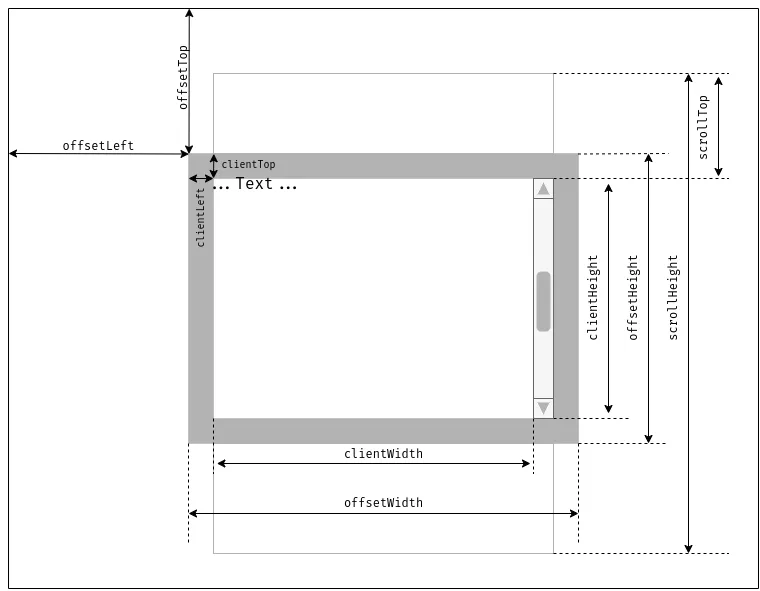Element Sizes & Scrolling
Sample element
<div id="example">...Text...</div>
<style>
#example {
width: 300px;
height: 200px;
border: 25px solid #e6e6e6;
padding: 20px;
overflow: auto;
}
</style>
Mind the scrollbar. If the scrollbar is
16pxwide then the content width remains only300 - 16 = 284px.
Geometry
Here's the overall picture with geometry properties:

offsetWidth: The outer width = inner CSS-width + paddings + bordersoffsetHeight: The outer height = inner CSS-height + paddings + bordersclientLeft: Left border widthclientTop: Top border widthclientWidth: The inner width = inner CSS-width + paddings (exclude scrollbar)clientHeight: The inner height = inner CSS-height + paddings (exclude scrollbar)scrollWidth: The full inner width including the scrolled out partsscrollHeight: The full inner height including the scrolled out partsscrollTop: How much is scrolled upscrollLeft: How much is scrolled left
Don't take width/height from CSS
We should use geometry properties instead of getComputedStyle:
CSS
width/heightdepend on another property:box-sizingthat defineswhat is
CSS width andCSS
width/heightmaybeautoA scrollbar
Window sizes and scrolling
Width/height of the window
documentElement.clientHeight;
documentElement.clientWidth;Not
window.innerWidth/innerHeightalert(window.innerWidth); // full window width alert(document.documentElement.clientWidth); // window width minus the scrollbar
Width/height of the document
Theoretically, as the root document element is document.documentElement, and it encloses all the content, we could measure the document's full size as document.documentElement.scrollWidth/scrollHeight.
But on that element, for the whole page, these properties do not work as intended. In Chrome/Safari/Opera, if there's no scroll, then documentElement.scrollHeight may be even less than documentElement.clientHeight ! Weird, right?
To reliably obtain the full document height. we should take the maximum of these properties:
let scrollHeight = Math.max(
document.body.scrollHeight,
document.documentElement.scrollHeight,
document.body.offsetHeight,
document.documentElement.offsetHeight,
document.body.clientHeight,
document.documentElement.clientHeight
);Get the current scroll
DOM elements have their current scroll state in their scrollLeft/scrollTop properties.
For document scroll: document.documentElement.scrollLeft/scrollTop
Speical properties: window.pageXOffset/pageYOffset
For historical reasons, these properties are the same:
window.pageXOffsetis an alias ofwindow.scrollX
window.pageYOffsetis an alias ofwindow.scrollY
Scrolling: scrollTo, scrollBy, scrollIntoView
window.scrollBy(x,y)- scrolls the page relative to its current positionwidnow.scrollTo(pageX, pageY)- scrolls the page to absolute coordinates, so that the top-left corner of the visible part has coordinates(pageX, pageY)ralative to the document's top-left corner. It's like settingscrollLeft/scrollTop
scrollIntoView
The call to elem.scrollIntoView(top) scrolls the page to make elem visible. It has one argument:
If
top=true(default), then the page will be scrolled to makeelemappear on the top of the window. The upper edge of the element will be aligned with the window top.If
top=false, then the page scrolls to makeelemappear at the bottom. The bottom edge of the element will be aligned with the window bottom.
Forbid the scrolling
document.body.style.overflow = "hidden";